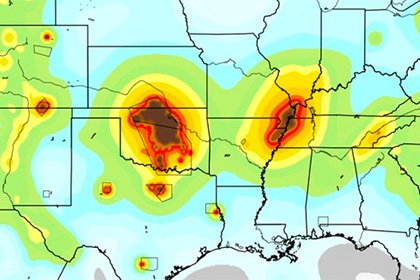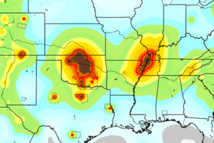- This law will ensure that Texas does not become a patchwork tailored with rules varying from region to region, from district to district and from city to city, - said the Republican.
The state authorities have been forced to take such a document after the November 2014, when Denton city residents voted for fracking near their town to be prohibited. The relevant legal provisions in a local referendum was supported by 58 percent of citizens. This decision was to prompted them, on the one hand, by traffic jams and noise arising from the work of oil, on the other – by many residents of Denton feared that the ecosystem may suffer because of fracking.
Denton is located in the largest US gas shale - Barnett Shale. That's where the world's first production of hydrocarbons has been tested by hydraulic fracturing. In other words, fracking was banned at fracking’s home.
Recall that in April, the US Geological Survey has unveiled the first official report on the impact of oil development on the seismic activity. Scientists have identified 17 dangerous areas in eight states, and said that such man-made earthquakes can reach magnitude 7 on the Richter scale - enough to cause a collapse of buildings.
Geologists have long known that the introduction of liquid into underground wells can raise the pressure in the pores of deep rock - it causes the last decisive blow to faults. However, the sharp increase in the number of small earthquakes in the central states of the US in recent years has drawn attention to this phenomenon. Increased seismic activity coincided with the beginning of the application of new methods for extracting oil and gas.
It is mainly about fracking when the mixture is injected in underground wellbore under high pressure, causing the gas or oil coming to the surface. However, it is not fracking that usually becomes the cause of tremors (this operation takes several hours, a maximum of days), but injection of wastewater into the aquifers, where the more extensive and dangerous cracks are located.
The red zone on the map (for example, Central Oklahoma) in the level of seismic hazard is already close to such states as California - the epicenter of the natural earthquakes in the west of the country. So far, the most destructive artificial earthquake in the US had 5.6-magnitude, epicenter of which fell on the city of Prague in Oklahoma (a few dozen houses collapsed then).
Geophysicists say that the oil and gas industry is capable of even more. "There are cracks large enough to cause an earthquake in seven points. We do not exclude this possibility, "- said report co-author Justin Rubinstein.
Typically, seismic hazard maps are compiled by the USGS basing on 50 years (this is also the average "life expectancy" of buildings). However, the intensity of man-made earthquakes depend on rapidly changing factors, such as wells sewage drilled in new areas, the fall in oil prices making production stop, the state governments changing the law governing the oil and gas industry.
For this reason, the new map considers a probability of earthquakes within one year. In addition, by the end of 2015, it will be reconsider ed- but even now, it brings practical benefits: the authorities, for example, can decide which state to repair the bridges first.
Recently, both scientists and officials have begun to take more seriously the threat of man-made earthquakes. I.e., April 21, 2015 Geological Survey of Oklahoma for the first time acknowledged that the recent acceleration of the tremors is not caused by natural causes, but by injection wastewater into reservoirs.
source: theguardian.com
The state authorities have been forced to take such a document after the November 2014, when Denton city residents voted for fracking near their town to be prohibited. The relevant legal provisions in a local referendum was supported by 58 percent of citizens. This decision was to prompted them, on the one hand, by traffic jams and noise arising from the work of oil, on the other – by many residents of Denton feared that the ecosystem may suffer because of fracking.
Denton is located in the largest US gas shale - Barnett Shale. That's where the world's first production of hydrocarbons has been tested by hydraulic fracturing. In other words, fracking was banned at fracking’s home.
Recall that in April, the US Geological Survey has unveiled the first official report on the impact of oil development on the seismic activity. Scientists have identified 17 dangerous areas in eight states, and said that such man-made earthquakes can reach magnitude 7 on the Richter scale - enough to cause a collapse of buildings.
Geologists have long known that the introduction of liquid into underground wells can raise the pressure in the pores of deep rock - it causes the last decisive blow to faults. However, the sharp increase in the number of small earthquakes in the central states of the US in recent years has drawn attention to this phenomenon. Increased seismic activity coincided with the beginning of the application of new methods for extracting oil and gas.
It is mainly about fracking when the mixture is injected in underground wellbore under high pressure, causing the gas or oil coming to the surface. However, it is not fracking that usually becomes the cause of tremors (this operation takes several hours, a maximum of days), but injection of wastewater into the aquifers, where the more extensive and dangerous cracks are located.
The red zone on the map (for example, Central Oklahoma) in the level of seismic hazard is already close to such states as California - the epicenter of the natural earthquakes in the west of the country. So far, the most destructive artificial earthquake in the US had 5.6-magnitude, epicenter of which fell on the city of Prague in Oklahoma (a few dozen houses collapsed then).
Geophysicists say that the oil and gas industry is capable of even more. "There are cracks large enough to cause an earthquake in seven points. We do not exclude this possibility, "- said report co-author Justin Rubinstein.
Typically, seismic hazard maps are compiled by the USGS basing on 50 years (this is also the average "life expectancy" of buildings). However, the intensity of man-made earthquakes depend on rapidly changing factors, such as wells sewage drilled in new areas, the fall in oil prices making production stop, the state governments changing the law governing the oil and gas industry.
For this reason, the new map considers a probability of earthquakes within one year. In addition, by the end of 2015, it will be reconsider ed- but even now, it brings practical benefits: the authorities, for example, can decide which state to repair the bridges first.
Recently, both scientists and officials have begun to take more seriously the threat of man-made earthquakes. I.e., April 21, 2015 Geological Survey of Oklahoma for the first time acknowledged that the recent acceleration of the tremors is not caused by natural causes, but by injection wastewater into reservoirs.
source: theguardian.com



















